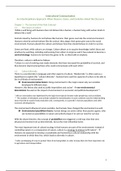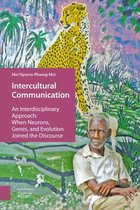Intercultural Communication
An Interdisciplinary Approach: When Neurons, Genes, and Evolution Joined the Discourse
Chapter 1 – The Survival of the Most Cultured
1.1 The nature of culture
‘While a wolf living with humans does not behave like a human, a human living with wolves tends to
behave like a wolf.’
Animals raised by humans do not behave like humans: their genes overrule the social environment.
Humans raised by animals behave like the animal, they adapt: their genes give way to the social
environment. Humans absorb the culture and behave how they should behave in order to survive.
Genes are fixed, while culture can change. Culture allows us to acquire knowledge, belief, ideas and
practices by watching, imitating and learning from others to improve and it has evolved to become a
survival strategy: humans do not have the genes to fly, so they build an airplane.
Therefore, culture is defined as follows:
‘Culture is a set of evolving man-made elements that have increased the probability of survival, and
thus become shared among those who could communicate with each other.’
1.2 Cultural diversity
There is a vast diversity in language and other aspects of culture. “Biodiversity” is often used as a
hypothesis to explain this “cultural diversity”: humans have used the capacity of culture to be able to
live in all kinds of environment.
Environmental determinism: living environment is the major reason why our societies
developed in different ways.
However, this theory also used to justify imperialism and racism* neo-environmental
determinism focused on the impact of environment on economic and political development**.
* African colonization was legitimized by the logic that tropical climates made people lazy and uncivilized.
** The number of wild plants and animals suitable for domestication in each continent was the initial deciding
factor that led to surplus food production and, consequently, to a growth in human populations and other
economic developments.
The environment influences human societies, but humans have changed the environment as well.
Environmental possibilism theory: human beings are active rather than passive agents, who
see numerous possibilities in nature and actively shape it to suit our need for survival.
With the above theories, the concept of probabilism was triggered: a mid-way view that sees
physical environment not as deterministic, but as the most influential factor.
The most important tent of cultural ecology is that humans are part of the environment: instead of
controlling nature or a consequence of nature, culture is a strategy to interact with nature*.
Humans are expected to develop a sustainable and harmonious cultural relationship with the
environment in which they live, which leads to diversity in culture.
* India: worshipping of cows to protect them from being killed, in order to keep them for their important role
in agriculture and transportation.
1
,Different cultures, but an identical environment is the consequence of culture as a survival strategy:
shared knowledge and resources in a group can be stolen, so a system is developed that allows
communication with someone to convince that cooperation is actually better than stealing
language, which facilitates deal making, negotiation and agreement.
The desire to manage cultural resources not only enables diverse languages to evolve, but also
channels people into different sub-groups cultural diversity becomes an element for us to
recognize an ingroup we can trust. Favouritism for those in the same group emerges (ingroup bias)
and own cultures are even seen as superior than that of others (ethnocentrism).
1.3 Diversity pathways
The gene-culture co-evolution theory is crucial in understanding human diversity: while culture
shapes the expression and selection of genes, genes also influence the adoption and formation of
certain cultural values (interaction of nature-nurture). It has the ultimate goal of evolving a culture
that provides a survival strategy that allows humans to advance.
The brain is the central hub where interactions of environment, culture and genes converge and
translate into behaviours. Brains across different cultures and contexts do not work the same way, as
the neural functions are shaped by culture and social experience the culturally patterned brain
enables us to voluntarily take actions that are appropriate in a specific culture.
The constant morphing and shifting of the brain tells us that our neural machinery system is
intrinsically malleable or has “plasticity”. The brain’s plasticity means that we are capable of adapting
to new environments and representing multiple cultures in our mind, depending on the context.
Brains do not come in male or female forms. If neural differences between men and women exist,
they should always be seen in specific cultural contexts. The brain is structured in a certain way
because the culture expects that, so a certain part of the brain is used more often.
Billions of neurons in the brain coordinate thoughts and behaviours, but behaviours shape the brain
as well. Repeated behaviours change the very structure and function of the brain, and have a
significant impact on culture, genes and environment.
Figure 1. The Diagram of Diversity Pathways
Our genes determine a lot about who we are and how we interact with others, but behaviours can
change our DNA as well*. Behavioural epigenetics is a discipline that tries to address how nurture
shapes nature. This has important implications for the health industry: treating diseases in progress,
while many diseases are preventable and reversible by influencing the genes.
* 90 per cent of heart disease is entirely preventable by changing diet and taking exercise.
2
, Social learning allows behaviour to be a dynamic force that both reflects and reshapes cultural
values simultaneously*.
* The public greeting “Heil Hitler”: people who did not support Hitler but had to follow him, experienced
cognitive dissonance while performing the greeting -> believing what they did was right to solve the cognitive
dissonance -> eventually, the behaviour influence the brain (what you believe).
The environment influences culture, in return, human cultures and behaviours have been reshaping
and changing the environment*.
* Aboriginals in Australia have been burning forests to promote grasslands for hunting, which affected the
timing and intensity of the summer monsoon.
1.4 Globalization
Resource management is a driving force for linguistic and cultural diversity: either safeguard
resources against outsiders, or negotiate resources with those we can trust. However, it can also lead
to merging of cultures: large groupings of people enable economies of scale (more production, same
costs). The need to sub-divide into small cultures was removed by a system that provides for us
sufficiently.
Humans are the only animal who can extend care beyond kinship to large numbers of unrelated
individuals. With a capacity for culture, we are able to bring down the genetic fence and welcome
strangers into our circle of trust this has become our subconscious, intuitive response, or “first
instinct”, which makes us cooperative.
Globalization is the ultimate stage of a cultural adaption process that endows with the psychological
capacity to cope with effective resource management, diversity, and other problems in the course of
existence. In the modern era, globalization is driven by different factors.
o Technology and information systems have reduced the distance between people.
o Unprecedented and rapid increase in and redistribution of the world’s demographics, which
is a burden on resources, the planet’s ecosystem and heightens the likelihood of conflicts.
o The growth of an unprecedented global economy: a globalized capital base, a global
corporate mindset, a global market presence, and a global supply chain.
As a result of exposure to different cultures and purposely changing our behaviours, our brains can
become culturally tuned and we are able to adapt to any culture. However, we have become so
interconnected, the interwoven network of international trading is prone to the “domino effect”:
“one person sneezes and everyone catches a cold.”
The capacity for culture allows us to juggle two contrasting incentives: (1) the tendency to diversify in
order to recognize those we can trust and to safeguard cultural resources and; (2) the tendency to
seek cooperation beyond kinship and ingroups in order to manage resources more effectively.
Chapter 2 – The Evolving Culture
2.1 The metaphorical tree of culture
Three major components of culture can be identified: fundamental concerns, values and outward
expressions.
Outward expressions-
-Values
Fundamental concerns-
Figure 2. The Metaphorical Tree of Culture
3






